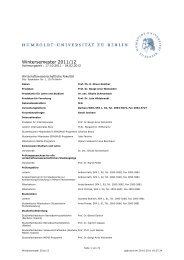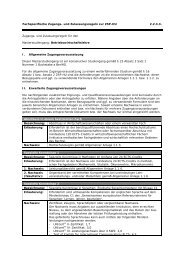Measuring the Effects of a Shock to Monetary Policy - Humboldt ...
Measuring the Effects of a Shock to Monetary Policy - Humboldt ...
Measuring the Effects of a Shock to Monetary Policy - Humboldt ...
You also want an ePaper? Increase the reach of your titles
YUMPU automatically turns print PDFs into web optimized ePapers that Google loves.
6 Bayesian FAVARs with Agnostic Identification<br />
itself is a very cumbersome computer intensive and memory intensive estimation method<br />
that applied <strong>to</strong> such large datasets might take very long <strong>to</strong> produce results. The challenge<br />
is <strong>to</strong> combine <strong>the</strong> Gibbs sampling with <strong>the</strong> agnostic identification procedure which itself<br />
is time consuming. How <strong>the</strong> code accomplishes this challenge is explained on <strong>the</strong> section<br />
about <strong>the</strong> Matlab implementation. Third we present results that seem reasonable and<br />
consistent with <strong>the</strong> conventional wisdom in like <strong>the</strong> ones by BBE. This indicates that<br />
<strong>the</strong> key <strong>to</strong> <strong>the</strong> question above is <strong>the</strong> identification scheme. More importantly <strong>the</strong> results<br />
confirm <strong>the</strong> lead <strong>of</strong> Sims <strong>to</strong> avoid unreasonable identifying assumption. Hence opposed <strong>to</strong><br />
<strong>the</strong> conclusion <strong>of</strong> BBE our results confirm that not only information is very important but<br />
one receives reasonable estimation results in combination with economically sound identi-<br />
fication schemes such as <strong>the</strong> agnostic identification using a broader set <strong>of</strong> sign-restrictions.<br />
The main results are that <strong>the</strong> Bayesian estimation <strong>of</strong> FAVARs combined with <strong>the</strong> ag-<br />
nostic identification <strong>of</strong> Uhlig [2005] deliver results according <strong>to</strong> <strong>the</strong> conventional wisdom<br />
where no prize puzzle arises. It seems <strong>to</strong> be <strong>the</strong> crucial issue why Bernanke, Boivin and<br />
Eliasz [2005] arrive at inferior results compared <strong>to</strong> <strong>the</strong> two-step principal component esti-<br />
mation. They apply a standard recursive identification scheme. Fur<strong>the</strong>rmore <strong>the</strong> greater<br />
information set allows <strong>the</strong> researcher <strong>to</strong> be more strict w.r.t. <strong>to</strong> <strong>the</strong> sign restrictions im-<br />
posed, in order <strong>to</strong> disentangle <strong>the</strong> dynamic effects <strong>of</strong> a shock <strong>to</strong> monetary policy more<br />
exactly.<br />
However one should be cautious with <strong>the</strong> conclusion, due <strong>to</strong> <strong>the</strong> fact that one should<br />
collect results for longer Gibbs iterations in order <strong>to</strong> assure <strong>the</strong> results. One should also<br />
try out several number <strong>of</strong> fac<strong>to</strong>rs and also report <strong>the</strong>ir contribution via variance decom-<br />
position.<br />
The next section gives an overview <strong>of</strong> <strong>the</strong> relevant literature followed by an introdution<br />
in<strong>to</strong> dynamic fac<strong>to</strong>r models in section 3. Section 4 starts <strong>to</strong> explain <strong>the</strong> FAVAR framework<br />
with its different identification and various estimation approaches. Fur<strong>the</strong>rmore a short



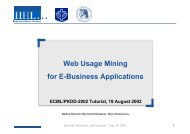
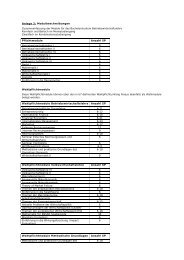

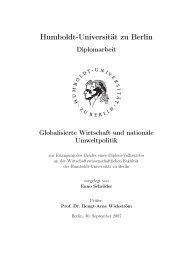
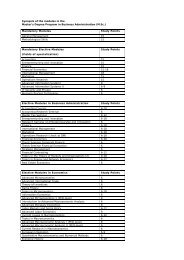
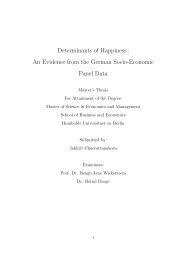
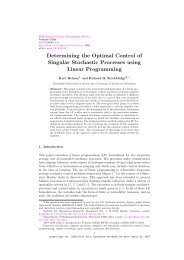
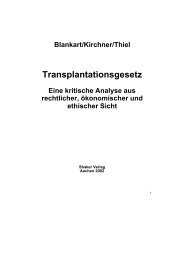
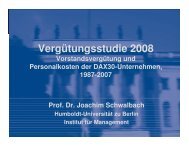

![[Text eingeben] [Text eingeben] Lebenslauf Anna-Maria Schneider](https://img.yumpu.com/16300391/1/184x260/text-eingeben-text-eingeben-lebenslauf-anna-maria-schneider.jpg?quality=85)

